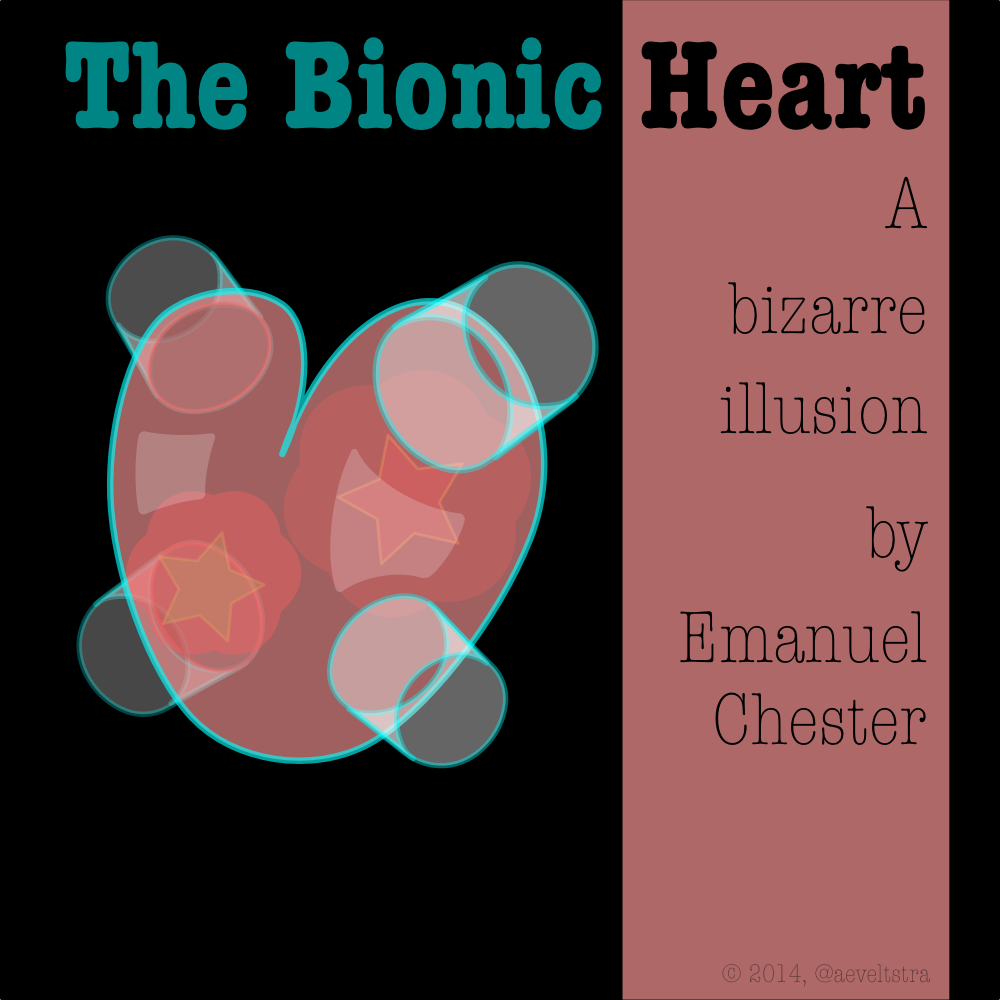Warning: shocking.
A surgeon cuts the beating heart out of a live patient, cleans it, shows it's bionic, reattaches it, and revives the patient. Script and story-line only; no instructions, no secrets, no reveals.
Emanuel Chester
March 13, 2014

Music starts playing: honkey-tonk piano, playing ditties known from slapstick comedy.
A surgeon comes on the the stage from thye side, in front of closed curtains. He is wearing green scrubs and a white lab coat. On his head he's wearing a flip-down spatter guard. In his hands an industrial circular saw, with oversized teeth. The surgeon laughs maniacally and activates the saw: it shoots sparks alongside the curtain.
Then the curtain opens. A grim, sterile visual presents itself, juxtaposing the comedic music style.
We see a hospital bed with some blinking machinery surrounding it, and a fluids tripod from which hang down several bags of saline and blood. We also see a trolly full of medical cutlery and tongs. Another trolly holds 2 cilindrical recepticles, both filled with a translucent fluid, otherwise empty, with a brass lid on top. One of them is labeled "sedative", and an orange decal is stuck to its front depicting black skull and bones.
The surgeon walks through the machines and trolleys, allowing the audience to take in the scenery and props. Overhang cameras zoom in on the utensils trolly and the blinking machinery, as the surgeon walks by. He lays the circular saw down on a trolly.
At that moment, 3 people walk onto the stage from the side. Two of them are dressed in scrubs, like nurses / assistants. One of the nurses is holding a clipboard. The 3rd is dressed as a patient, in a green hospital gown. This person is a woman. Apparently something is wrong with her: she seems groggy, off-balance, staggering.
The surgeon begs the nurses to lift the patient onto the hospital bed. To do this, the one nurse puts her clipboard down on a trolly. The bed is positioned sideways, so the audience has a clear view of the patient in full length.
With a stethoscope the surgeon listens to the patient's heartbeat. Subsequently he pulls a line out of a nearby blinkin machine, and attaches it to the patient's chest. We now hear a highly irregular heartbeat drowning out the honkey-tonk music. The blinking machine blinks with the same irregularity. The music adepts, and starts sounding like the minimalistic compositions by Philip Glass.
After a short instruction from the surgeon, the nurses start hooking up the saline solution and the blood to the patient's arm. We see the blood flowing down the clear plastic line. While the surgeon walks over to retrieve the circular saw, the nurses cover the patient's body with a thin, white sheet, draping it from the back to the front.
The patient sees the saw and panics, sits up, ready to leave. She is pushed down by one nurse, while the other grabs an oversized syringe, puts its needle into a recepticle labeled "sedative", brings it back over to the patient, pushes the air out of the syringe, and jabs the needle into the patient's leg, causing her to jump. Quickly after that, with the music changing to a lullaby, the patient drops back down onto the hospital bed, falling asleep.
The nurses fasten a neck brace over the patient, bolting it to the bed, securing the white cover sheet as well.
The music changes to death metal. The surgeon revs the buzzsaw, letting sparks fly out over the patient. He then approaches more closely, and starts cutting into the patient's chest, starting near her head, and going down over her sternum, stopping its end. Sparks, blood, as well as white and green cloth material shoot out over the patient's abdomen and legs, made highly visible by the white sheet that is covering her.
"Expanders!", the surgeon calls out. One of the nurses hands him a pair of expansion tongs, which he places in-between the sawed-open ribs. With a couple of turns on a screw, and some highly audible cracks, the ribcage opens up, each side standing upright from the patient's chest, exposing its bloody contents.
"Ah, there's the problem!", the surgeon points out, allowing an overhang camera to zoom in to his hands. He jabs both hands into the bloody mess, and pulls up what appears to be the patient's heart. "Clamp!" he commands, making both nurses rush close with a clamp each. They fasten the clamps on arteries, as the surgeon grabs a pair of oversized scissors, and cuts through those arteries.
He lifts the freed heart out of the chest, holding it high, causing blood to ooze out over his surgical gloves and drip onto his white coat and scrubs. He brings the heart over to the non-labeled cylindrical vessel, lifts the lid, and drops the heart into the liquid, which slowly turns red from the blood. The surgeon reaches in with 1 hand, grabs the heart, trashes it about in the liquid, and pulls it back out.
The heart now appears void of any flesh and blood. It clearly looks like a mechanical device. It doesn't move, doesn't make any noise, doesn't blink.
One nurse stays with the patient, monitoring her vital signals. The other goes over to the surgeon and pushes a machine closer, grabbing a line, and plugging it into the heart. Nothing happens. The nurse taps a gauge, and rotates a dial, looks back at the heart. Still nothing.
"Paddles," the surgeon instructs, handing the mechanical heart to the nurse. He reaches over to the machine, draws out 2 heart defibrilation paddles, and tests them, causing a loud bang, a bright spark, and a puff of smoke. After the smoke clears, he places the paddles on each side of the heart, instructing the nurse to let go. "Clear?" he asks. "Clear!", confirms the nurse. Another loud bang and spark indicate the paddles have electrocuted the heart.
Through the smoke, a weak light starts blinking from the heart. "Aha! Success!", shouts the surgeon. The line is still attached to the heart, and the needle in the gauge next to it pans out every time the heart blinks. We hear a mechanical valve opening and closing, in the same rhythm.
After handing the heart back over to the nurse, the surgeon puts the paddles back on the machine. He rolls it closer to the patient, followed by the nurse, who waits alongside the patient. The surgeon takes back the heart and places it in the patient's rib cage. 2 Fastening rings are placed into the rib cage too, each pushed over the end of a clamped artery. An overhang camera shows this clearly and unmistably on a large screen.
The surgeon pushes each artery over the appropriate heart output, using a screwdriver to fasten the rings. The heart continues to blink. Then one nurse pulls the line out, after which the machine stops reacting to the heart. Also, the music stops.
A loud cracking noise accompanies the closing of the rib cage, pushed in from the sides by the nurses. The surgeon grabs a staple gun from the trolly, tests it out on a clipboard, and then proceeds to staple up the patient's rib cage.
They try to revive the patient, but she doesn't seem to snap out of the sedation. "Paddles?" a nurse asks. The surgeon nods, "yes!". They grab the heart defibrilation paddles, test them again (spark, bang, smoke), and place them on the patient: one paddle near the shoulder, and the other diagonally opposed to it near the free-hanging ribs. "Clear?" asks the surgeon. "Clear!" acknowledge the nurses as they raise their hands.
Bang! A spark and a puff of smoke escape from the patient. It didn't help. "Again! Clear?" "Clear!" Bang! Now we hear a heartbeat, and we see a light blinking from the patient's closed chest. Sweet classical music starts playing, as the patient sits up slowly.
The nurses put away all the tools. The surgeon pulls away the dirty sheet, and swivels the bed so that the patient faces the audience. The green hospital gown she is wearing now displays a large slit across the patient's chest. It is drenched in blood, and gets pushed apart by the patient's bossom. Through it, we can clearly see the nasty, stapled-shut wound.
As the nurses help the patient stagger off stage, the curtain closes.
Wouldn't you like your events to make a lasting impression?

Send in this contact form, or mail me at emanuel.chester@protonmail.com.